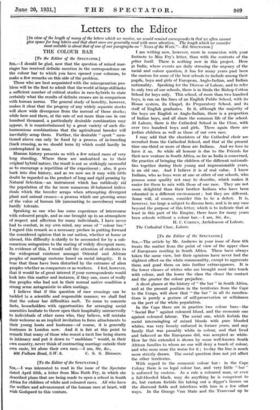[To the Editor of the SPECTATOR.] Sia,—I was interested to
read in the issue of the Spectator dated April 25th, a letter from Miss Ruth Fry, in which she described plans that are being made to open a school in South Africa for children of white and coloured races. All who have the welfare and advancement of the human race at heart, will Wish Godspeed to this venture. THE I am writing now, however, more in connexion with your footnote to Miss Fry's letter, than with the contents of the letter itself. There is nothing, new in this project. Here in India, where events are daily stressing the urgency of the racial and colour question, it has for many years past been the custom for some of the best schools to include among their pupils, boys and girls of European, Anglo-Indian, and Indian nationality. Speaking for the Diocese of Lahore, and to refer to only two of our schools, there is in Simla the Bishop Cotton School for boys only. This school, of more than two hundred boys, is run on the lines of. an English Public School, with its House system, its Chapel, its Preparatory School, and its staff of English graduates. In it, although the majority of the boys are English or Anglo-Indian, there is a proportion of Indian boys, and all share the common life of the school. At Lahore, there is the Cathedral School in the Close, with over two hundred boys and girls. There. again there are Indian children as well as those of our own race.
I may add that the choristers of the Cathedral choir are recruited from the Cathedral School, and that at the present time one-third or more of these are Indians. And we love to have it so. So while all honour is due to the Friends for their new venture in South Africa, as far as India is concerned, the practice of bringing the children of the different nationali- ties together during their young and impressionable years, is an old one.. And I believe it is of real value. I know Indians, who as boys were at one or other of our schools, who possess some quality not easy to describe, which makes it easier for them to mix with those of our race. They are not more delightful than their brother Indians who have been educated in a different environment ; but they are different. Some will, of course, consider this to be a defect. It is, however, too large a subject to discuss here, and is in any case beyond the purpose of this letter, which is to indicate that at least in this part of the Empire, there have for many years been schools without a colour bar.—I am, Sir, &c.,










































 Previous page
Previous page